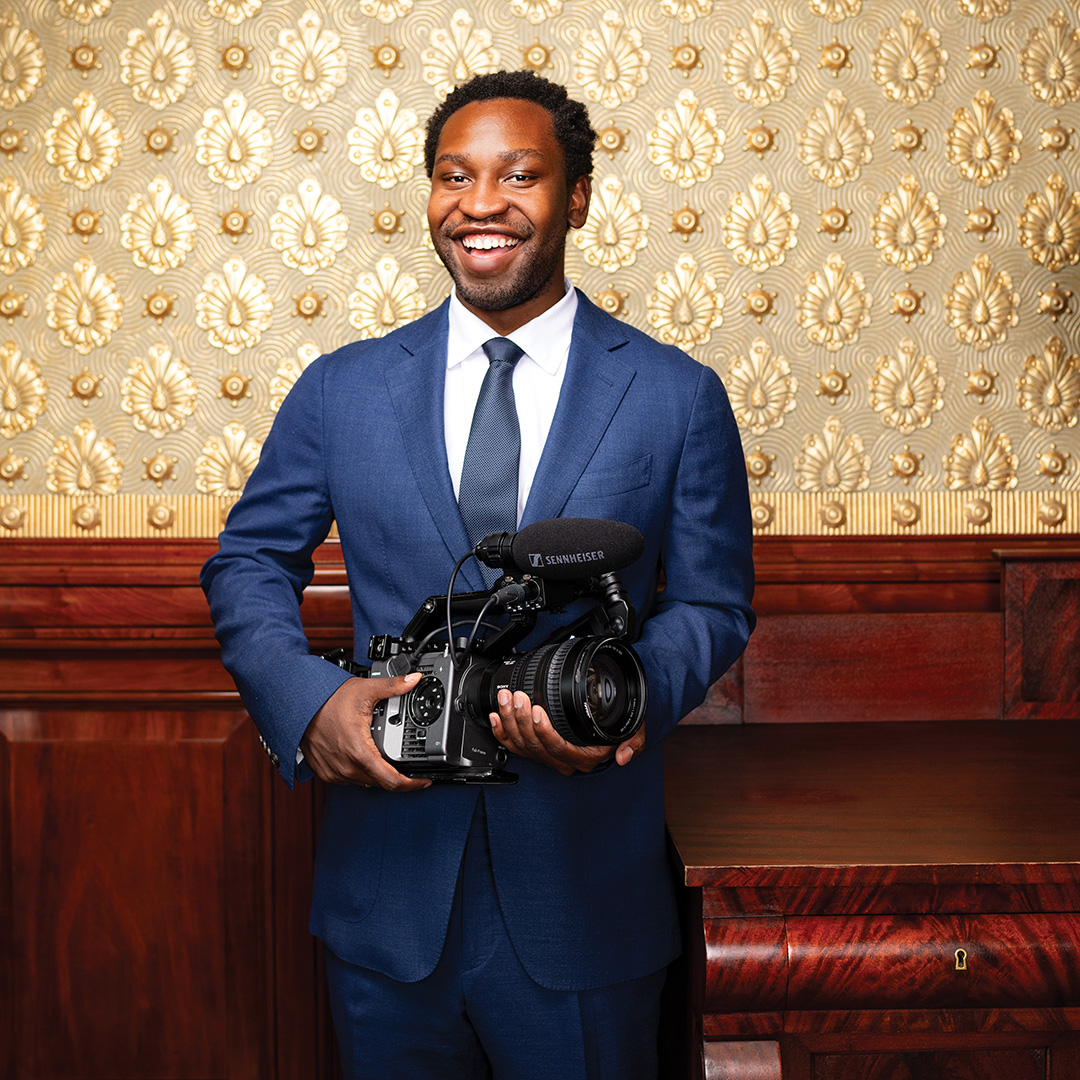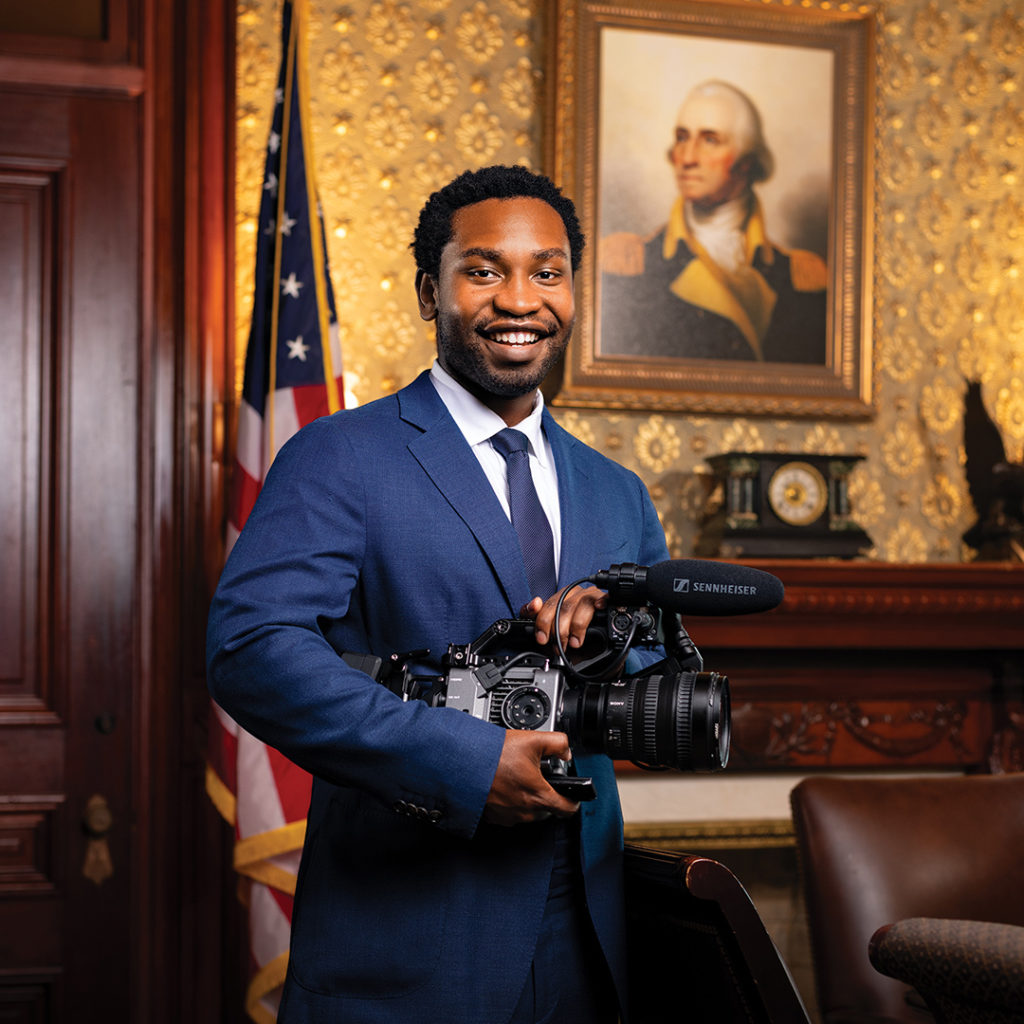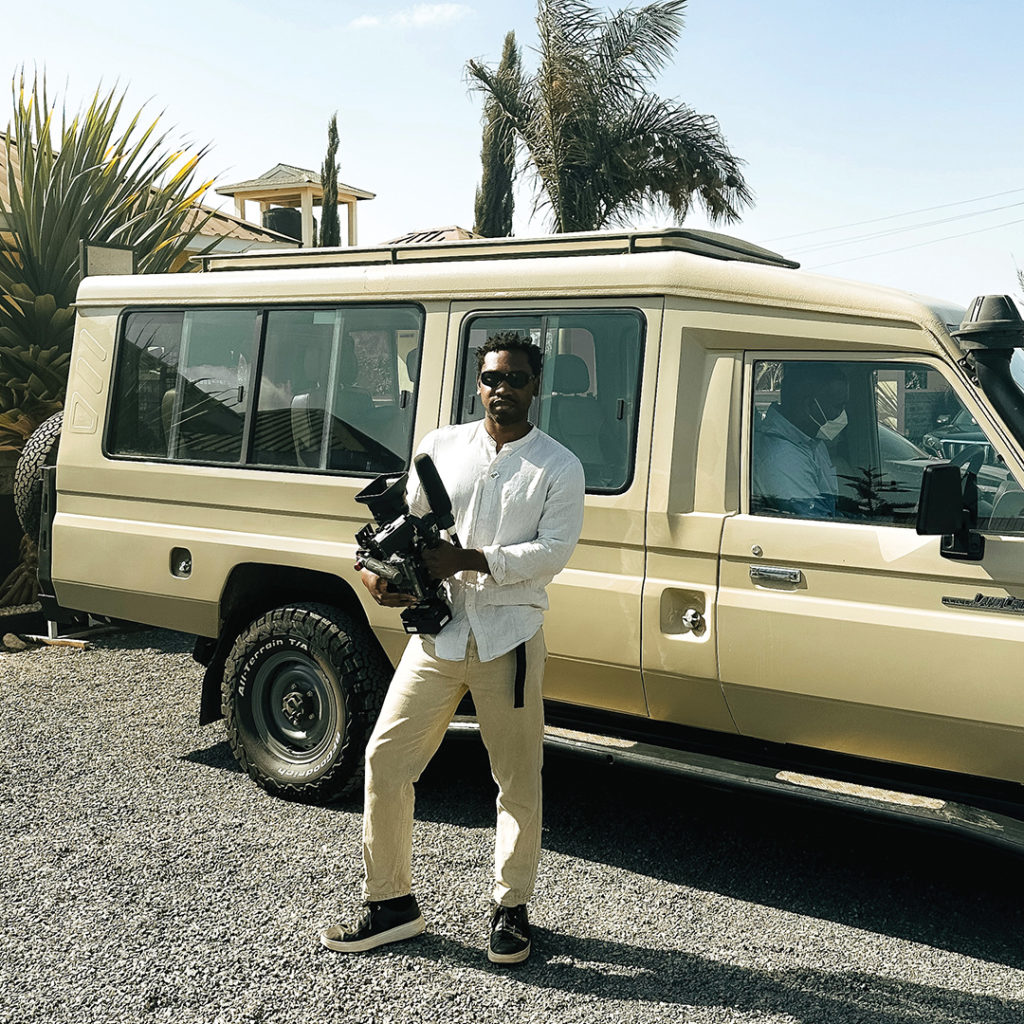In the house
Aaron Wilson Watson ’18 takes his shot as White House videographer.

Aaron Wilson Watson
It sounds like the setup of a good joke: “I walked into the room and there were two presidents, two vice presidents, two first ladies, and a second gentleman …” Only for Aaron Wilson Watson ’18, it’s not a joke. It happened on the second day of his new job as senior video producer in the White House Office of Digital Strategy. Watson took time from his busy schedule to talk to TCNJ Magazine about what it’s like to be a White House staffer. (He couldn’t really turn us down — he worked in TCNJ’s Office of Communications, Marketing, and Brand Management, first as a student worker and then as a staff photographer, and his photos have graced our pages for years.) Now, for his words.
TCNJ Magazine: Tell us about the moment when you first stepped into the White House.
Aaron Wilson Watson: Actually, it was nerve-racking. There’s a lot of security when you come into the White House. There’s a line to show your ID card, and you have to put in codes in different places in order to enter. The first days, I was shuffling, I was dropping my card. I was fumbling with the code.
TM: Is your office in the White House? Do you look around each day and wonder, “How did I get here?”
AW: My office is in the Eisenhower Executive Office Building. It’s next door to the White House, and that’s where most of the administration’s staff offices are located. On my first day, while I was in line to get my badge, I started talking to the person next to me; his cousin was my fourth-grade teacher at Lawrence Intermediate School, Ericka Smoots. It was a nice moment where I was in this larger-than-life building with a larger-than-life opportunity, and I thought, “Oh, wait. I belong in this space and my people are here.”

TM: This is all a big change from your office in Green Hall.
AW: Yes, in some ways it is. But, in other ways it is similar. The building is a place that represents the past and future. However, the kindness of the people reminds me of TCNJ. I imagined this place to be very serious. But I work in what people call the “video palace,” which is a creative oasis. The Office of Digital Strategy has a special type of creative energy that has to be there because of the nature of the work that we do. We have all these souvenirs from various shoots over the years. So there’s slime from when Nickelodeon visited, images from when Lady Gaga sang at the inauguration, and memes posted around. And I’m the only guy on my team, which is really awesome in the sense that film and video tend to be a male-dominated space. My team is made up of powerful women and there is a culture here that is far more collaborative than you might otherwise see. I am constantly learning from them all.
TM: Talk about your first event in the East Room.
AW: The first time I was in the East Room was noteworthy. President Biden invited the Obamas back to the White House for the official unveiling of their portraits. It was on my second day here, September 7, 2022. And everyone’s there — President Biden, First Lady Jill Biden, Barack and Michelle Obama, Vice President Kamala Harris, and Second Gentleman Douglas Emhoff.
TM: How did you even know what to do if it was only your second day?
AW: It was quite something to see how the team came together. You could tell there was clear muscle memory for covering East Room events. I suggested that we do an Obama-focused camera for the event, and so I worked the camera that cut to former President Obama. That was the first time that I got my hands on a camera here, too. As everyone was looking at the portraits being unveiled, my camera was focused on Biden and Obama’s faces. It was surreal. Rarely do you get two presidents in the same room.
TM: I bet it was hard to beat that.
AW: The real pinching-myself moment was after the unveiling, when I went to Adam Schultz’s office. He’s President Biden’s official photographer. Pete Souza, former President Obama’s photographer, was there. He’s someone I really look up to. I’m a video producer and director, but I also have a photography mindset, and so to see these photographers interact was such a cool moment.
TM: Have you been in the actual Oval Office?
AW: Yes, I have. The thing is, you never really know when you will be going into the Oval Office. Sometimes it’s on the schedule. There may be a bilateral meeting (where leaders of two different countries get together); or when Biden hosted the cast of Ted Lasso to talk about mental health. That was from the Oval. But then there are times where the night before you think it is going to be a normal day and then boom, you’re in there.
TM: Is there a “normal” day for you?
AW: There’s no normal day here. The hours can vary from day to day. For example, when the French delegation came for a state visit, we had an early start. And there have been times when we’ve arrived back from a trip late. When I went to Kenya, we got back to the White House around midnight, so one of the photographers and I were literally lugging our suitcases on the North Lawn in the middle of the night.

TM: Explain what type of videos you are producing, and how they are used.
AW: My goal is to communicate the work the administration is doing in a concise way. My team’s videos are shown on the White House, POTUS, and FLOTUS social media channels. I think about how to best show an interaction in a 30-second video, but there’s also the reality that I am documenting history. For example, my team filmed the last COVID-19 update from Dr. Anthony Fauci, President Biden’s chief medical adviser. That was a historic moment. Another time, President Biden and Vice President Harris met with the “Tennessee Three” (Representatives Justin Jones, Justin Pearson, and Gloria John who joined demonstrators outside of the statehouse to demand stricter gun laws). I was the only videographer in the Oval Office for a portion of the meeting. I captured varied shots and angles to create a short video. But I also kept rolling for the historical record.
TM: Were there any situations that you could have never imagined, or could have only happened in this job?
AW: There are so many. But for one example, I was on the ground floor of the White House, and everyone stopped. And I was like, “OK, what’s happening? Something is happening.” It was a principal movement. Principal movements are when one of the four principals — the president, the VP, the first lady, or the second gentleman — is on the move. For security reasons, everyone holds or pauses, and we move away from the path to let the principal pass.
TM: You mentioned Kenya earlier. Do you travel to cover international events with the president?
AW: I go back and forth between covering the president, the first lady, or the White House in general. I am with the president more often domestically. A lot of my travel has been with the first lady. I’ve been to Paris with her. And then to Africa, mainly Kenya and Namibia. We went there to reaffirm the U.S. commitment to supporting Africa, an initiative the president spoke about last year at the U.S.-Africa Leaders Summit. We also went to Kajiado, a very remote village, and we saw the effects of a drought. And the first lady was on the front lines, advocating for support for water accessibility.

TM: Do you fly on Air Force One?
AW: I have been on Air Force One. I flew with the president and the first lady to survey the devastation from the Maui wildfire. The stakes were high. I had to cover it in a way that showed the importance of what was happening while being sensitive to and respecting the affected community. The president assured the community it would get the resources it needs, and he committed to speaking personally to everyone who wanted to talk. We were at one community event for hours where he did just that. The devastation was like nothing I had ever seen. And yet, what they call the “Aloha spirit” was still there. There was so much hope, so much joy, and so much resilience in spite of such loss.
TM: When you are covering these significant, national, and global events, what are you thinking from behind the lens? What are you trying to convey to the country and how do you do that?
AW: My primary goal for this job is to increase empathy. And we do that with real-people stories. So it can be the survivors of the Sandy Hook school shooting who are of age and who are growing into activist roles for gun reform, like their counterparts in Parkland, Florida. We sent out the videos of the interviews with them but also edited a piece with them that was interwoven with the president’s voice of what he’d like to see done. Both were really heartfelt.
At the State of the Union, my focus was on interviewing the first lady’s invited guests. I got to speak with the parents of Tyre Nichols, a Black man who was around my age and was murdered by police in Tennessee. It took everything in me to keep it together as I spoke with them. Last October, I traveled with the first lady to San Francisco for a Cancer Moonshot event. That one was personal: my mom had breast cancer, and I was her caregiver. I met with the head of the American Cancer Association. Then in April, there was a White House event to commemorate an Executive Order to expand support for caregivers. I saw one of the activists in an elevator and she said, “This day means so much.” In moments like that, I feel like I am making a difference. There are these incredible stories of resilience or survivorship, but there are also people who advocate for these issues, too. You can see the work of this administration in the lives of people.
TM: How do you stay true to yourself in a job like this?
AW: We have something called the tradesman route, and that’s typically how I will enter and come through the White House now. That’s where the kitchens are, and the floral shop, and those kinds of things. And that’s what I walk through daily. I think about all of the people who historically had to use the tradesman route — those enslaved servants, Black folks — and I situate myself in the space. I ask myself, “What am I here for? Why am I doing this?” This job is about pushing the president’s agenda, and he says, “This is the People’s House,” and I really try to stay connected and grounded in that. We typically think of politics as maybe convoluted, and separated from us as individuals. Most people think that inside these walls there’s a lot of cynicism and selfishness. But when you actually get here, and you work inside of government, you realize there are real people who care. I’ve met so many different people inside the administration, or who have worked with the administration, who are very genuine and sincere. They are doing work that I don’t think we always talk about, but has real impact. And that’s been a beautiful thing to see.
Pictures Mike Morgan and Courtesy Aaron Wilson Watson
Posted on October 12, 2023

